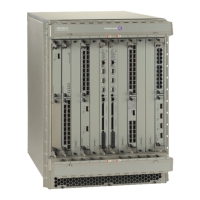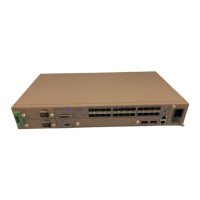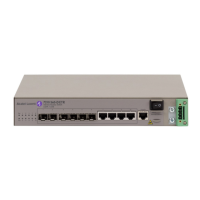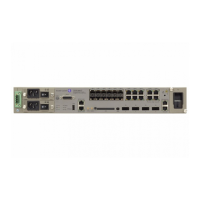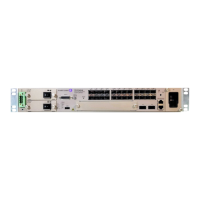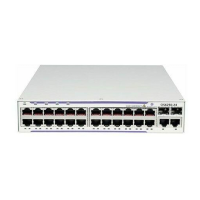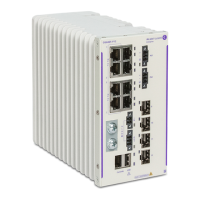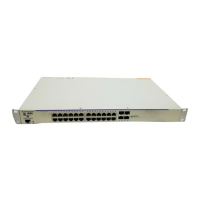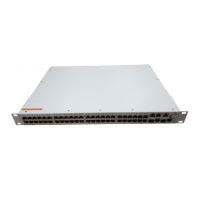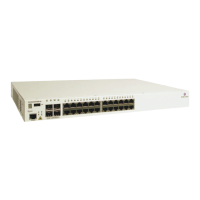Do you have a question about the Alcatel-Lucent 7450 ESS-7 and is the answer not in the manual?
Describes system concepts, configuration explanations, and examples for SR-OS boot option file (BOF), file system, and system management.
Intended for network administrators responsible for configuring 7450 ESS-Series routers, assuming understanding of networking principles.
Provides process flow information to configure basic router and system parameters, operational functions, and boot option tasks.
Explains the hierarchical, inverted tree structure of the SR OS CLI, including contexts and scopes.
Details how to access, configure, and manage routers using the CLI, including context navigation and command syntax.
Lists and describes console control commands used for navigating the CLI and displaying session information.
Covers commands for controlling session preferences and CLI prompt display within the root>environment context.
Describes monitor commands for displaying statistical information related to subjects at a configurable interval.
Explains using 'help' and '?' commands for assistance with CLI commands, syntax, and keywords.
Lists special keystrokes for editing commands while typing in the CLI.
Explains executing CLI commands in any context by specifying the full path from the CLI root.
Details using numerical ranges as arguments in command lines, limited to positive integers.
Explains using the pipe feature to search files for strings or patterns and provides examples.
Introduces the 'vi' visual editor for editing ASCII files like configurations and BOF.
Lists commonly used line-editing commands in the EX editor, accessed via ':' in vi.
Describes the detailed behavior and CLI usage of the rollback feature, including creating checkpoints and reverting.
Explains the SR OS file system for storing system files like images, configurations, and logs.
Details the file system's basis on DOS, naming of compact flash devices (cf1, cf2, cf3), and removability.
Describes file arguments modeled after URLs, categorizing them into local, ftp, and tftp types.
Explains using standard DOS wildcard characters (*) and (?) in file commands for pattern matching.
Outlines basic system tasks for file management: modifying attributes, creating directories, copying, moving files.
Explains using the 'md' command to create new directories in the local file system, one level at a time.
Details 'copy' and 'scp' commands for uploading/downloading files and copying between hosts via SSH.
Explains using the 'move' command to relocate files or directories from one location to another.
Describes using 'delete' and 'rd' commands to remove files and empty directories; data is unrecoverable.
Explains using 'dir' to list files/subdirectories and 'type' to display file contents.
Describes using the 'repair' command to check compact flash devices for errors and repair them.
Covers SR OS software on compact flash for system initialization, including hardware init and boot file search.
Details locating and loading runtime images and config files per BOF parameters.
Explains the BOF persist parameter for preserving system indexes across reboots, crucial for NMS.
Describes LI for monitoring communications, configurable for all service types.
Illustrates startup process, assuming successful location of boot loader, BOF, and config files.
Provides BOF config caveats: compact flash install and loading sequence.
Provides information on configuring BOF parameters using the CLI.
Outlines tasks performed by the BOF file: port setup, IP addressing, static routes, system parameters.
Details essential BOF parameters: primary address, image, config locations.
Overview of basic system tasks: BOF setup, CLI access.
Explains configuring BOF parameters: address, static routes, persistence.
Covers service management tasks: viewing, modifying, saving configs, deleting BOF params, rebooting.
Explains saving running configs to files, with options for default/non-default parameters and index files.
Details saving configs with unique filenames for backup copies and text editor editing.
Explains reboot command for routers, CPMs, IOMs, and upgrading boot ROMs.
Provides reference for BOF configuration commands and syntax.
Covers management Ethernet port config: address, autonegotiation, duplex, speed.
Specifies if system indexes are preserved across reboots when save command is executed.
Details specifying primary config file name and location, with fallbacks.
Specifies primary directory for runtime image loading, with fallbacks.
Assigns IP address to management Ethernet port on active/standby CPM.
Details commands for configuring system management: name, location, time zones, NTP, SNTP, CRON.
Covers system info: name, contact, location, coordinates, naming objects.
Covers time zone and summer time config for local time display and clock sync.
Details NTP protocol, stratum levels, elements, and configuration.
Explains SNTP client for system clock sync with external time sources.
Describes the CRON feature for scheduling tasks: actions, scripts, and time ranges.
Discusses HA routing options and features to diminish network vulnerability and outages.
Explains redundancy features for duplicating data and software functionality for service continuity.
Explains 1:1 redundancy and system synchronization methods.
Covers administrative tasks: chassis mode config, saving configs, network timing.
Details chassis modes (a, b, d) corresponding to scaling and feature sets of IOM types.
Explains saving config changes to prevent loss on reboot using explicit/implicit syntax.
Discusses network timing capabilities: SDH/SONET, Sync Ethernet, PTP.
Displays UDP and TCP connection information, including protocol, addresses, and state.
Displays CPU utilization per task over a sample period, showing utilization and capacity usage.
Enters context to display cron schedule parameters: action, script, time range details.
Enables context to show redundancy info: multi-chassis, MC-endpoint, MC-lag, MC-ring.
Displays PTP configuration and state: clock type, domain, peer info.
Configures PTP clock type (master/slave, boundary), defining BMCA behavior.
Configures the profile for the internal PTP clock, defining BMCA behavior.
Configures a remote PTP peer, providing context for parameters like IP address and authentication.
Lists various standards and protocols supported, including IEEE, ITU-T, and RFCs.
Details protocol support for OSPF, BGP, MPLS, IS-IS, RIP, and TCP/IP.
Provides general information and RFCs related to MPLS architecture and DiffServ.
Lists RFCs related to LDP Applicability for MPLS.
Lists RFCs related to IPSec, Security Architecture, and IKE.
Lists RFCs related to IPv6 specifications, addressing, and autoconfiguration.
Lists RFCs related to IP Multicasting, IGMP, PIM, and MSDP.
Lists ITU-T and ETSI standards related to voice and video performance.
Describes system concepts, configuration explanations, and examples for SR-OS boot option file (BOF), file system, and system management.
Intended for network administrators responsible for configuring 7450 ESS-Series routers, assuming understanding of networking principles.
Provides process flow information to configure basic router and system parameters, operational functions, and boot option tasks.
Explains the hierarchical, inverted tree structure of the SR OS CLI, including contexts and scopes.
Details how to access, configure, and manage routers using the CLI, including context navigation and command syntax.
Lists and describes console control commands used for navigating the CLI and displaying session information.
Covers commands for controlling session preferences and CLI prompt display within the root>environment context.
Describes monitor commands for displaying statistical information related to subjects at a configurable interval.
Explains using 'help' and '?' commands for assistance with CLI commands, syntax, and keywords.
Lists special keystrokes for editing commands while typing in the CLI.
Explains executing CLI commands in any context by specifying the full path from the CLI root.
Details using numerical ranges as arguments in command lines, limited to positive integers.
Explains using the pipe feature to search files for strings or patterns and provides examples.
Introduces the 'vi' visual editor for editing ASCII files like configurations and BOF.
Lists commonly used line-editing commands in the EX editor, accessed via ':' in vi.
Describes the detailed behavior and CLI usage of the rollback feature, including creating checkpoints and reverting.
Explains the SR OS file system for storing system files like images, configurations, and logs.
Details the file system's basis on DOS, naming of compact flash devices (cf1, cf2, cf3), and removability.
Describes file arguments modeled after URLs, categorizing them into local, ftp, and tftp types.
Explains using standard DOS wildcard characters (*) and (?) in file commands for pattern matching.
Outlines basic system tasks for file management: modifying attributes, creating directories, copying, moving files.
Explains using the 'md' command to create new directories in the local file system, one level at a time.
Details 'copy' and 'scp' commands for uploading/downloading files and copying between hosts via SSH.
Explains using the 'move' command to relocate files or directories from one location to another.
Describes using 'delete' and 'rd' commands to remove files and empty directories; data is unrecoverable.
Explains using 'dir' to list files/subdirectories and 'type' to display file contents.
Describes using the 'repair' command to check compact flash devices for errors and repair them.
Covers SR OS software on compact flash for system initialization, including hardware init and boot file search.
Details locating and loading runtime images and config files per BOF parameters.
Explains the BOF persist parameter for preserving system indexes across reboots, crucial for NMS.
Describes LI for monitoring communications, configurable for all service types.
Illustrates startup process, assuming successful location of boot loader, BOF, and config files.
Provides BOF config caveats: compact flash install and loading sequence.
Provides information on configuring BOF parameters using the CLI.
Outlines tasks performed by the BOF file: port setup, IP addressing, static routes, system parameters.
Details essential BOF parameters: primary address, image, config locations.
Overview of basic system tasks: BOF setup, CLI access.
Explains configuring BOF parameters: address, static routes, persistence.
Covers service management tasks: viewing, modifying, saving configs, deleting BOF params, rebooting.
Explains saving running configs to files, with options for default/non-default parameters and index files.
Details saving configs with unique filenames for backup copies and text editor editing.
Explains reboot command for routers, CPMs, IOMs, and upgrading boot ROMs.
Provides reference for BOF configuration commands and syntax.
Covers management Ethernet port config: address, autonegotiation, duplex, speed.
Specifies if system indexes are preserved across reboots when save command is executed.
Details specifying primary config file name and location, with fallbacks.
Specifies primary directory for runtime image loading, with fallbacks.
Assigns IP address to management Ethernet port on active/standby CPM.
Details commands for configuring system management: name, location, time zones, NTP, SNTP, CRON.
Covers system info: name, contact, location, coordinates, naming objects.
Covers time zone and summer time config for local time display and clock sync.
Details NTP protocol, stratum levels, elements, and configuration.
Explains SNTP client for system clock sync with external time sources.
Describes the CRON feature for scheduling tasks: actions, scripts, and time ranges.
Discusses HA routing options and features to diminish network vulnerability and outages.
Explains redundancy features for duplicating data and software functionality for service continuity.
Explains 1:1 redundancy and system synchronization methods.
Covers administrative tasks: chassis mode config, saving configs, network timing.
Details chassis modes (a, b, d) corresponding to scaling and feature sets of IOM types.
Explains saving config changes to prevent loss on reboot using explicit/implicit syntax.
Discusses network timing capabilities: SDH/SONET, Sync Ethernet, PTP.
Displays UDP and TCP connection information, including protocol, addresses, and state.
Displays CPU utilization per task over a sample period, showing utilization and capacity usage.
Enters context to display cron schedule parameters: action, script, time range details.
Enables context to show redundancy info: multi-chassis, MC-endpoint, MC-lag, MC-ring.
Displays PTP configuration and state: clock type, domain, peer info.
Configures PTP clock type (master/slave, boundary), defining BMCA behavior.
Configures the profile for the internal PTP clock, defining BMCA behavior.
Configures a remote PTP peer, providing context for parameters like IP address and authentication.
Lists various standards and protocols supported, including IEEE, ITU-T, and RFCs.
Details protocol support for OSPF, BGP, MPLS, IS-IS, RIP, and TCP/IP.
Provides general information and RFCs related to MPLS architecture and DiffServ.
Lists RFCs related to LDP Applicability for MPLS.
Lists RFCs related to IPSec, Security Architecture, and IKE.
Lists RFCs related to IPv6 specifications, addressing, and autoconfiguration.
Lists RFCs related to IP Multicasting, IGMP, PIM, and MSDP.
Lists ITU-T and ETSI standards related to voice and video performance.
| Brand | Alcatel-Lucent |
|---|---|
| Model | 7450 ESS-7 |
| Category | Switch |
| Language | English |
